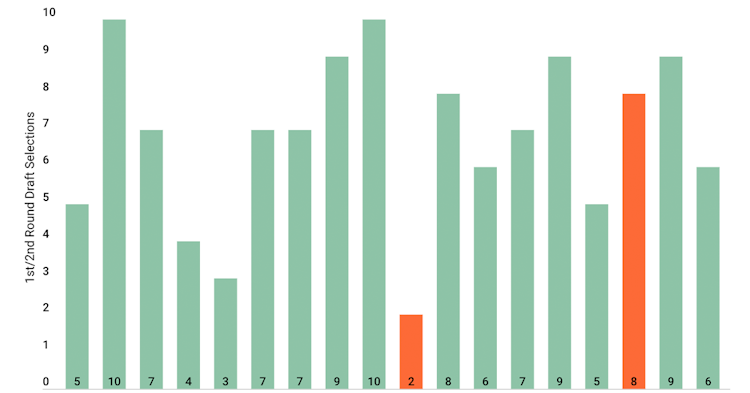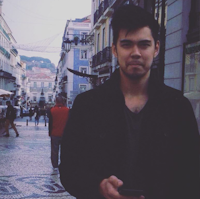The Hawks and Swans: Two Former Heavyweights Heading In Opposite Directions
Last updated: Jul 28, 2020, 5:00AM | Published: Jul 28, 2020, 2:21AM
On a wet, miserable Saturday at the SCG, the last embers of this Hawthorn era might have finally burned out.
It didn't end with glory or anything glory-adjacent, but with James Frawley losing his cool and pushing a cackling Tom Papley. It ended with Jack Scrimshaw losing his mind and dropping a mark and making the wrong choice between a kick and a handball.
The era ended more emphatically in September 2016 when the Hawks' quest for four in a row was ended by the Bulldogs. But in the past few years it's kind of lethargically dragged on, like a TV show trying to eke out a couple more seasons despite the main narrative being more or less resolved.
Defining characters like Luke Hodge, Sam Mitchell, Jordan Lewis, Cyril Rioli, Jarryd Roughead and Josh Gibson are long gone, but there are still nine holdovers from the 2015 premiership team, and the Hawks have famously since gone with the strategy of supplementing their list with acquired veteran talent, instead of dedicating themselves to youth and a younger regeneration.
The Swans have gone the other way.
Sydney never got seduced by any desire to try and hang on after their time as a contender ended in 2017. Instead they pivoted straight away to blooding young talent. No marquee veterans were brought in - Dan Hannebery, Gary Rohan and Zak Jones all moved elsewhere, and a number of older mainstays retired.
The Swans have made eight picks in the first two rounds of the draft over the past three years. The Hawks have made two, and made none in 2017 or 2018.
 This made Saturday afternoon all the more dire.
This made Saturday afternoon all the more dire.
Against the Hawks, the average Swan had played 73 games, while the average Hawk had played 120. Sydney's two veterans of 150+ games went up against Hawthorn's nine. The Hawks were more experienced, bigger, stronger, more skilled, and much more incentivised… and lost.
RELATED: For Young And Old: How Age And Experience Affect AFL Results
At 3-5, and completely broken, Hawthorn's season is probably beyond saving.
The Hawks typically struggle in the contest but use the ball exquisitely when they do have it. Against Sydney, they dominated contested ball and clearances yet butchered the ball, showing how off kilter things have gotten at Hawthorn.
Wonderfully skilled players played as though they were blinded by a bad dream.
Jack Gunston picked out lone Sydney targets in between two Hawks. Ben Stratton took his time, carefully measured passes, and delivered them straight to Swans. Chad Wingard and Liam Shielsmessed up forays toward goal so poorly and uncharacteristically that it felt like something was wrong with their boots, the grass, the ball, or the world.
It was just something wrong with Hawthorn, though. For a month, the Hawks have been playing a petrified, conservative brand, almost physically unable to take risks or move the ball with any fluency, speed or adventure. Every exit from defence is the same - a lateral kick to where half-back hugs the boundary line and then a long kick down the line, leading to repeat stoppages, the area of the game the Hawks are worst at.
While the Hawks were strangled by hesitation, the Swans played fast and loose. In the second half, Hawthorn played anxious, as though with every possession they could feel an entire year slipping away, while the Swans played with freedom, as though one very winnable game was there for the taking.
The game turned when Sydney started using the corridor in the second half. One sublime Lewis Taylor pass inboard to Allir Allir in the third quarter that led to a Tom Papley goal set the game alight.
Papley was game's dominant actor, Hawthorn's chief antagonist, and his double-goal in the second quarter made a game that Hawthorn seemed to have in hand feel suddenly nervy. That little prod was enough for the Hawk angst to take over and do the rest.
Papley's energy - his mad opportunism and crazed dash inside 50, smashing the ball into the ground more than bouncing it - was an apt reminder of everything the Hawks were lacking.
Tom Papley has TAKEN OVER!
— AFL (@AFL) July 25, 2020
He turned his man 60m out and TOOK OFF 🚀
Enter @Telstra #5GFastestFootballer at https://t.co/xS8ACsakad#AFLSwansHawks pic.twitter.com/jU898v9uEe
Hawthorn will get better because they can't get worse. There's too much talent in the ranks still, and skilled players will not spend the next nine games finding opponents with their passes.
There are clear deficiencies - Jack Gunston as the key aerial target doesn't work, the defence is too slow, and the midfield isn't big enough - but this is not the second worst team in the league, which the Hawks have played like the past month.
The second worst team might be the Swans, not that they should care for now.
They have notable young talent gaining experience and a clear plan going forward. On Saturday they played like a team that knows exactly where it is and where it wants to go, and toppled a team that seems to have little idea about either of these things.
Did you enjoy this article? Join our free mailing list to get the best content delivered straight to your inbox, or join the conversation by leaving a comment below or on the Stats Insider Twitter or Facebook page.



